TAY binders contain site report leaflets categorized in a user-friendly and effective manner for those interested, which can be grouped or classified to suit different purposes. To date, TAY Project has published 13 binders:
- Palaeolithic/Epipalaeolithic (April 1996),
- Neolithic (May 1997),
- Chalcolithic (June 1998),
- Early Bronze Age (2 binders) (May 2002),
- The 14C Database of Archaeological Settlements in Turkey (November 2003),
- The Cave Inventory of Turkey (2 binders) (April 2006),
- The Greek-Roman Period of Pisidia and Caria Regions (February 2007),
- The Byzantine Building Inventory of Marmara Region (April 2007),
- Iron Age (2 binders) (January 2008).
- The Byzantine Building Inventory of Central Anatolia Region (April 2015),
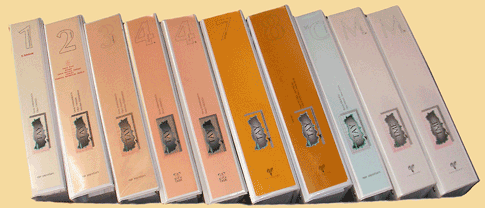
Each site report is prepared and maintained with the help of the database management system. The TAY team does routine updates of the content on the web site.
The Byzantine Building Inventory of Central Anatolia Region
Sustained its existence in Anatolia with its capital being Istanbul (Constantinopolis) for about 11 centuries, the Byzantine civilization is one of the last archeological levels of Anatolia and Thrace, while the remains of its material culture –at least those which are on the ground- comes second in Turkey, only after the monuments of Ottoman civilization. The building inventory of Byzantine period for Central Anatolia region has been published...
The inventory prepared by Engin Akyürek, Özgü Çömezoglu, Ayça Tiryaki, Ali Yamaç, Nilay Karakaya, Mete Mimiroglu, Ferda Barut, Tolga Uyar, Seçkin Evcim and 7 contributing people, and contains all the Byzantine buildings and architectural remains in Central anatolia Region, dated from the beginning of Byzantine period (330) till its ending (1453).
• 622 buildings and building remains from Aksaray, Ankara, Çankiri, Çorum, Eskisehir, Karaman, Kayseri, Kirikkale, Kirsehir, Konya, Malatya, Nevsehir, Nigde, Sivas and Yozgat provinces of Central Anatolia Region,
• A bibliography consisting of 551 publications on Byzantine architecture in Central Anatolia Region,
• About 450 visual materials containing building plans and drawings,
• 2 maps pinpointing the selected Byzantine buildings in General Map of Central Anatolia Region and Selected Areas in Cappadocia,
• “Mini Byzantine Glossary for the Enthusiast” containing 168 words,
• An introductory article on the Byzantine civilization in Central anatolia by Engin Akyurek,
• Also an index of all buildings showing the distribution by provinces and districts, and the abbreviations used in the inventory are included to the folder.
(The hardcopy is only in Turkish) |
 |
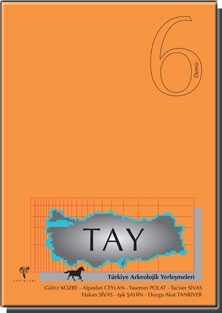 |
Iron Age Inventory
“The Late Hittite city-states, the Urartians, Phrygians, Lydians, and Lycians, each played a role in the political arena, that arose along with the Iron Age (1200–330 BC) in Anatolia and Thrace. The Anatolian Peninsula was under the rule of many dynasties, big and small, during this age. Among the significant civilizations, built during that era, particularly worthwhile mentioning are the Late Hittites in the Southeastern Anatolia, the Eastern Mediterranean, and partially the Central Anatolia, as well as the Urartians, which are the forefathers of the Hurrians, the Phrygians in the Central Anatolia, the Lydians in the Western Anatolia, the Lycians in the Southwestern Anatolia, and the Ionians in the Aegean Region. Along with the Egyptians, the Phoenicians, and the Babylonians, these communities shaped the roots of the modern world culture, by significantly effecting the Hellenistic Civilization."
The TAY Project has now published the Iron Age Settlements Inventory in two binders, which enlightens one of the most important civilization milestones of Anatolia, and Thrace.
The TAY Iron Age Inventory was created by Gülriz Kozbe, Alpaslan Ceylan, Yasemin Polat, Taciser Sivas, Hakan Sivas, Isik Sahin, Duygu Akar Tanriver, and the contribution of over 10 scientists, in a period of 3 years.
The inventory contains 2343 settlements in 7 different regions.
• Out of these 2343 settlements 182 were published as leaflets, 2068 as mini-leaflets – due to insufficient availability of data except for the location descriptions and the research information-, and 93 were only listed settlements –due to lack of any data except for the name of the province, district, and village, where the settlement was located at,
• The References Section of the Iron Age Inventory contains 1686 publications on the Iron Age Researches,
• The Inventory also contains 185 visual material including settlement plans, architectural elements, and finds,
• The “Mini Iron Age Glossary for the Enthusiast” inside the Inventory contains 146 words,
• An introductory articles section, entitled “Evaluations on the Iron Age Researches in Turkey”, consisting of the sections "Thrace and the Eastern Marmara" (Isik Sahin), "Aegean Region" (Yasemin Polat), "Central Anatolian Region" (Taciser Sivas – Hakan Sivas), "Black Sea Region" (Hakan Sivas - Gülriz Kozbe - Alpaslan Ceylan ), "Eastern Anatolian Region" (Alpaslan Ceylan - Yasin Topaloglu ) and "Southeastern Anatolian Region" (Gülriz Kozbe) written by the explorer/writers was included inside the Iron Age Inventory,
• Additionally an index containing all the settlement names enlisted both alphabetically, and in the order of the region they are located in, along with the definitions of the abbreviations were included in the inventory.
• A map pinpointing the selected Iron Age settlements in Turkey.
(The hardcopy is only in Turkish) |
The Byzantine Building Inventory of Marmara Region
Sustained its existence in Anatolia with its capital being Istanbul (Constantinopolis) for about 11 centuries, the Byzantine civilization is one of the last archeological levels of Anatolia and Thrace, while the remains of its material culture –at least those which are on the ground- comes second in Turkey, only after the monuments of Ottoman civilization. The building inventory of Byzantine period for Marmara region has been published...
The inventory prepared by Engin Akyürek, Ayça Tiryaki, Özgü Çömezoglu, Melda Ermis and 14 contributing people, and contains all the Byzantine buildings and architectural remains in Marmara Region, dated from the beginning of Byzantine period (330) till its ending (1453).
• 431 buildings and building remains from Balikesir, Bilecik, Bursa, Çanakkale, Edirne, Istanbul, Kirklareli, Kocaeli, Sakarya, Tekirdag and Yalova provinces of Marmara Region,
• A bibliography consisting of 1152 publications on Byzantine architecture in Marmara Region,
• About 300 visual materials containing building plans and drawings,
• 2 maps pinpointing the selected Byzantine buildings in Marmara Region and Istanbul,
• “Mini Byzantine Glossary for the Enthusiast” containing 138 words,
• An introductory article on the Byzantine civilization by Engin Akyurek,
• Also an index of all buildings showing the distribution by provinces and districts, and the abbreviations used in the inventory are included to the folder.
(The hardcopy is only in Turkish) |
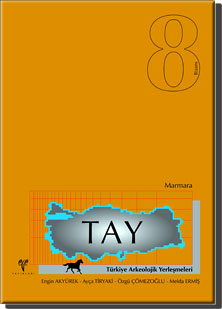 |
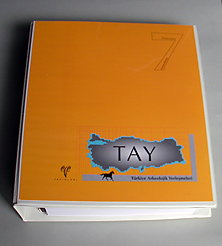 |
The Greek-Roman Period Inventory of Pisidia and Caria Regions
Clouds dispersed over another period of 2 regions in Anatolia:
The inventory of Greek-Roman Period settlements in Pisidia-Caria regions is published...
The settlements located in Pisidia-Caria regions from Protogeometric Period (c. BC 950) till the end of Roman Emperor Theodosius (AD 378-395) Period are included in this inventory, which is prepared by Senem Ozden and Mete Aksan.
• There are 282 settlements from Pisidia Region (Afyon, Burdur, Isparta, Konya) and 273 settlements from Caria Region in the inventory.
• 1511 publications about Pisidia and Caria researches are located at the bibliography of the inventory.
• A map in dimensions of 57x29 cm is added to the folder as well as the 200 visual material consisting of city plans, architectural drawings and finds.
• There is also a “Mini Greek-Roman Glossary for the Enthusiast” containing 70 words in the folder.
• There are two articles in the folder: “Cultural Heritage Dated to Greek and Roman Period in Pisidia Region” by Senem Ozden and “An Assessment on Caria Region Archaeology” by Mete Aksan.
• In addition to these, indexes sort by site names and by regions and the definitions of the abbreviations used in the inventory are added to the folder.
(The hardcopy is only in Turkish)
|
The Cave Inventory of Turkey
"Connected to the surface where at least one man can get in... Some span for several meters while others for several miles: They extend through the 'centre of the earth' or continue parallel to the surface. Such caves have provided shelter for 'humans' and other creatures since the Palaeolithic and are also home to natural sculptures, hidden from the destructive effects of climatic conditions. Their existence immemorial, they have seen and buried many lives, entrusted to the domain of Hades. Occasionally they are severed from their connection to the outside world by extensive coverage. They have bodies, arms, ceilings, rivers and lakes. For some they are feared and creepy, while others find them exciting, yet they forever carry their mysterious character. Luring and attractive, humankind offered a gift of their first artistic endeavour, carving and painting their walls…'
What will you find in the Cave Inventory folders?
The folders provide accessible information for approximately 2327 caves, including exploration findings of the Turkish karsts, some dating back to mid-19th century. Information about 467 caves is published as leaflets, while 919 caves compiled of partial information on their locations and history of exploration are documented as mini-leaflets. In addition, 941 caves are published in as a list format due to a lack of detail apart from geographic information in terms of province, district and village. Some 200 caves and rock shelters also documented in the Cave Inventory carry evidence of archaeological deposits and remains. In addition, the plans and sections drawn from measurements of 386 caves are included in the hardcopy of the inventory (Cave plans and sections presented as mini-leaflets or in list format are not published in the hardcopy, however available on TAY internet site ).
|
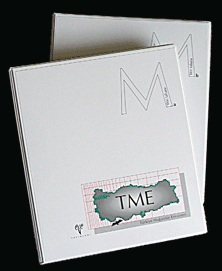
Following the well-established TAY tradition, we have also provided a 'Mini-Speleology Glossary' and a 'Geological Time Period and Evolution of Life Table'; tables for symbol definitions and abbreviations; a bibliography consisting of over a thousand publications, and; of course, various indexes. You will also find a map comprising the distribution of approximately 500 caves at the end of the 2nd folder (all caves will soon take their place in TAYGIS).
(The hardcopy is only in Turkish)
|

|
Sözcük Tabaný - Word Base
Base de Mot - Wort Basis
The "TAY Word Base" is the result of heavy labour dealt with sporadically since 1995. It has flourished through the valuable contribution of many people, presented initially as printed media. During its development, many sources have been reviewed, and many additions and propositions have been made.
Pocket-sized, it is a suitable reference book for experts and students who working in the field of archaeology and history, but also caters for anyone interested in past-time cultures. The objective is to make words available at hand when you required, whilst reading archaeological texts in different languages or working for international projects.
It is a database providing archaeological terminology and other supporting sciences in Turkish, English, French and German: hence its title “Word Base”. The preceding abbreviation, TAY, is included to highlight the Word Bases' wide use and improvement by The Archaeological Settlements of Turkey (TAY) throughout the past 10 years. Our goal to share this data pool with you two years ago has only just been materialised.
|
|
TAY has Published Radiocarbon Dates of Archaeological Settlements in Turkey...
Ten years ago, TAY Project had set out to compile an inventory of archaeological settlements in Turkey. An important part of this group of data, "The 14C Database of Archaeological Settlements in Turkey", has now been uncovered and assembled and is ready for use. The 2nd and last volume of 14C (radiocarbon) dates, which contains Early Bronze Age and later periods, has also been published (the 1st part was published in 2003).
The purpose of this undertaking is to compile all previously published 14C dates in order to produce a chronology of Anatolia/Thrace. We believe that this data group, calibrated by TAY Project, will fill an important void in the inventory of Turkey.
In this folder, all settlements with radiocarbon analysis have been prepared as updatable leaflets. Each leaflet includes geographical information about the settlement; explanations of the 14C samples; a table of 14C dates according to the phases, samples, and laboratories; and calibration curves. Part one of the folder includes two important articles: “Radiocarbon Dating Method” by Dr. Mustafa Özbakan, and “Chronology of Anatolia According to Comparative Tables” by Dr. Burçin Erdogu. A comprehensive bibliography and chronological tables showing all settlements with 14C dates have also been added to part two.
(The hardcopy is only in Turkish)
|
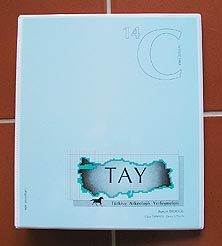
|

|
Structure of Settlements Volumes
Each finding and settlement location has its own unique leaflet. The leaflets are ordered alphabetically, with no other classifying indicator (i.e. page number, section header) in order to allow each user to group and categorise according to their own needs. Therefore the user can easily change the order based on her/his interests according to region, period, etc.
The first section on each leaflet has information related to the identity of the settlement, its geographic location with a map illustration and other general features. The second section contains information about the excavation(s) conducted at the site, details of findings, references to related publications and updates. Each leaflet has approximately 20 to 30 fields of geographic/archaeological information, as well as further literary references. The back of each leaflet contains drawings of typical artefacts that may be found at the site.
|
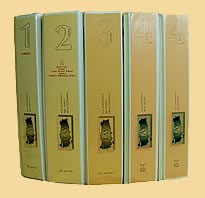
|
In each folder, the leaflets are followed by a comprehensive bibliography related to the period covered, a comparative chronological chart with neighbouring regions and a map depicting the spatial distribution of the sites.
For the first five folders containing more than 3300 leaflets (Palaeolithic, Neolithic, Chalcolithic, and EBA) more than 3200 publications (articles, books, reports, etc.) have been examined.
|
Harmankaya, S. - O. Tanindi, TAY - The Archaeological Settlements of Turkey-1: Palaeolithic/Epipalaeolithic, Ege Publishing Co., Set ISBN 975-807-003-7, Volume ISBN 975-807-004-5, Istanbul, 1996.
Harmankaya, S. - O. Tanindi - M. Ozbasaran, TAY - The Archaeological Settlements of Turkey-2: Neolithic, Ege Publishing Co., Set ISBN 975-807-003-7, Volume ISBN 975-807-010-X, Istanbul, 1997.
Harmankaya, S. - O. Tanindi - M. Ozbasaran, TAY - The Archaeological Settlements of Turkey-3: Chalcolithic, Ege Publishing Co., Set ISBN 975-807-003-7, Volume ISBN 975-807-019-3, Istanbul, 1998.
Harmankaya, S. - B. Erdogu, TAY - The Archaeological Settlements of Turkey-4a/4b: Early Bronze Age, TASK Foundation Publications, Set ISBN 975-6637-08-0, Volume ISBN 975-6637-09-9, Istanbul, 2002.
Erdogu, B. – O. Tanindi – D. Uygun, The 14C Database of Archaeological Settlements in Turkey, Ege Publishing Co., ISBN 975-6637-13-7, Istanbul, 2003.
Tanindi, O. (Ed.), arkeo / archaeo / archéo / archäo - Sozcuk Tabani / Word Base / Base de Mot / Wort Basis, Ege Publishing Co., ISBN 975-807-111-4, Istanbul, 2005.
Gurcan, G. - A. Yamac - S. Kirlangic - M. Pelen - Z. Talay - P. Zorlu,, TAY - The Cave Inventory of Turkey-Ma/Mb, Ege Publishing Co., ISBN 975-807-128-9, Istanbul, 2006
Ozden, S. - M. Aksan, TAY - The Archaeological Settlements of Turkey-7: Greek-Roman Period / Pisidia and Caria Regions, Ege Publishing Co., Set ISBN 975-807-157-2, Volume ISBN 975-807-158-0, Istanbul, 2007.
Akyurek, E. - A. Tiryaki – O. Comezoglu – M. Ermis, TAY - The Archaeological Settlements of Turkey-8: Byzantine Period / Marmara Region, Ege Publishing Co., Set ISBN 978-975-807-003-9, Volume ISBN 978-975-807-166-1, Istanbul, 2007.
Kozbe, G. - A. Ceylan - Y. Polat - T. Sivas - H. Sivas - I. Sahin - D.A. Tanriver, TAY - The Archaeological Settlements of Turkey-6a/6b: Iron Age, Ege Publishing Co., Set ISBN 978-975-807-003-9, Volume ISBN 978-975-807-182-1, Istanbul, 2008.
Akyurek, E. - O. Comezoglu – A. Tiryaki – A. Yamac - N. Karakaya - M. Mimiroglu - F. Barut - T. Uyar - S. Evcim, TAY - The Archaeological Settlements of Turkey-8: Byzantine Period / Central Anatolia Region, Ege Publishing Co., Set ISBN 978-975-807-003-9, Volume ISBN 978-605-4701-59-9, Istanbul, 2015.
|
 To purchase the binders and publications To purchase the binders and publications
please contact the following address or click on the logo
|
|















